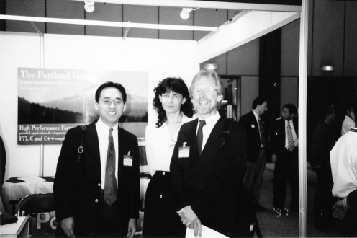
Prof. Bordes, Prof. Palithorpe, and Tanaka
(from roght to left)
Visitor: Yoshio Tanaka (Parallel and Distributed System Performance TRC Laboratory) Period: April 27 - May 2, 1997 (6 days) Place (conference attended): HPCA '97 in Seoul
The HPCA '97 (High Performance Computing Asia '97) was held in the Republic of Korea coincidentally with what we call in Japan "Golden Week" - a week from April 29 to May 5 which includes four national holidays. I will report on my trip to Korea to make a presentation, and share and exchange information with researchers from other countries at the HPCA '97.
The HPCA was established under the proposal of Dr. David Kahaner of ATIP and is jointly held by Asia-Pacific Rim countries. This was its 2nd meeting following the 1st one held in Taipei in September 1995.
The Seoul conference offered a variety of events including tutorial programs, technical sessions, panel discussions, round table discussions, and exhibitions. I was impressed by the serious intention of the Korean Ministry of Information-Communication, the sponsor of HPCA '97, to make the conference a success-I noticed they obtained the official support from the IEEE (Institute of Electrical and Electronic Engineers) of the USA, and the conference site at the Seoul Hilton Hotel offered spacious halls and advanced equipment. Various attractions included a traditional dance performance by a Korean traditional performance troupe. It was a really big conference attracting 720 people from 20 countries.
Offered on the first day (April 28) were a one-day and 10 half-day tutorial sessions. They covered a wide range of high performance computing subjects including an overview of distributed shared memory systems and an implementation program of Java. In addition to the tutorial programs, the 1st Cenju Workshop was held under the co-sponsorship of NEC and the University of Houston.
The main programs started on the 2nd day (April 29). During the plenary talks in the afternoon, Professor Jack Dongarra of the University of Tennessee and Professor Yoshio Oyanagi of the University of Tokyo delivered lectures.
Professor Dongarra described the present status of high performance computing in the United States and his own group's research activities, mainly featuring Netsolve. Professor Oyanagi talked about the current status and future development of parallel architectures and parallel software. I had already attended Prof. Oyanagi's lecture several times in Japan. Yet, his speech at the conference was impressive as he made a comparison of parallel processing research scenarios chiefly between the United States and Japan.
I made a presentation entitled "A Comparison of Collective Communication Performance and Its Application" in the afternoon on the third day. I explained that we keep the basic collective communication performance on various types of parallel computers as a database, and make data and benchmark programs accessible for outside researchers through the Internet. Also, I reported on our method for analyzing the performance of data parallel programs as an application of the database. A number of researchers seemed to be surprised to find that a workstation cluster connected through Myrinet can offer such a high degree of performance comparable to Paragon and CM-5. Also, a user of Paragon asked me about its parallel performance properties. On the whole, the audience highly evaluated my speech and I was later told that my paper was nominated for the final elimination round for the Best Paper Award.
Found in the list of HPCA exhibitors were 21 corporations including SGI-Cray, HP, DEC, IBM, NEC, Hitachi and Fujitsu. I enjoyed the opportunity to hear explanations about various types of parallel computers. I found that all exhibitors offered games with prizes for winners. Unfortunately, however, I couldn't take part because everything was conducted in the Korean language.
The photo below shows Professor Nicole Bordes and Professor Bernard Pailthorpe of the Sydney Regional Visualization Laboratory. I met them in the exhibition hall. Prof. Bordes' field is image processing and he visited the RWCP's Tsukuba Research Center.
I missed some sessions because five sessions were held simultaneously. I was also disappointed that the time allowed for presentations was only 20 minutes, including question-and-answer time. Still the five-day conference was suggestive and meaningful for the future development of our research activities.
